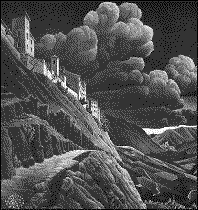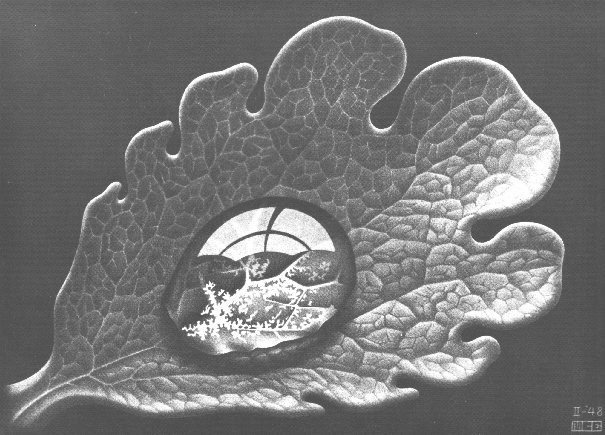Art : Escher
The Life of M. C. Escher
 Born
in 1898 in the
Dutch province of Friesland, Maurits Cornelis Escher
was the son of a respected civil engineer. During his early years at
school, Escher displayed a passion for drawing but seemed disinterested in
mathematics and other subjects. He never officially graduated from
secondary school.
Born
in 1898 in the
Dutch province of Friesland, Maurits Cornelis Escher
was the son of a respected civil engineer. During his early years at
school, Escher displayed a passion for drawing but seemed disinterested in
mathematics and other subjects. He never officially graduated from
secondary school.
Escher and his family moved to Oosterbeek, Holland when he was
nineteen. He became increasingly interested in literature and began
writing poetry. The next year, he matriculated at the Higher Technology
School in Delft where he began to study architecture. While he was able to
defer his military service so that he could study, Escher grew ill and was
not able to keep up with his school work. So, in 1919, he decided that it
was finally time to join the military. However, his sickness prevented him
from passing the physical exam, and he, in turn, was not allowed to
continue his studies in Delft.
By this time, Escher had begun experimenting with the mediums of
linocuts and woodcuts.
Next, Escher moved to Italy which was a very important step. It
was there, in 1921, that he began drawing cityscapes and plant-life. Two
years later, he met his Jetta Umiker, who soon became his wife.
Around this time, Escher made his first trip to Spain. In Granada, he
visited the Alhambra Palace, which is famous for its Moorish (Arabic)
decorative styles. While he wouldn't come back until over a decade later,
these decorations would prove to be a great
influence over much of his
later work.
Throughout the early 1920s, Escher continued his artistic work and
held his first one-man show in 1923 in Siena. This was followed by another
show in Holland. Everything was going well for Escher: his work was
well-received, he was married, and he had just bought a home outside of
Rome. But, tragedy struck in 1925 when a freak mountaineering accident
took the life of his brother. This inspired Escher to create his famous
"Days of Creation" woodcuts.

Escher was rapidly becoming very famous and, when his first child
was born the next year, King Emmanuel and Benito Mussolini attended the
christening. His work was so well-appreciated by 1929 that he was able to
hold five shows in Holland and Switzerland in that year alone. The next
year, he created "Castrovalva," (pictured on right) his famous
lithograph of a mountainside
village, and, in 1934, his print "Nonza" won third prize in a festival
sponsored by the Art Institute of Chicago.
In 1936, Escher traveled through Europe and afterwards produced
"Still Life with Street," based on a
sketch that he had drawn during his
trip. This was a very important print because it was his first to feature
an impossible reality. It was an art drawn from his mind rather than an
art drawn from simple observations
1936 also brought Escher back to Alhambra Palace for the second
time, site of the intricate Moorish tilings.
Critics see this visit and
his European tour as being responsible for pushing him into new creative
directions.
Escher started to play around with plane-filling techniques and
transformations over the next few years. He experimented with different
ways to give the impression of objects extending out into infinity: by
scaling the objects smaller and smaller as they approached the center of
the picture, by blurring objects as they
approached the border, or by
simply shrinking the objects as they got closer to the border. This was
when Escher first created an image of two birds flying in opposite
directions, a motif which would come up in several of his later works and
was the idea behind his famous print "Day and
Night."
 In 1946, the technique of mezzotint was added to Escher's
repertoire. This process allowed Escher to add a further level of detail
and intricacy to his pictures. With the use of this new technique, he was
able to draw very fine lines and delicate shading. An example of one of
his mezzotint drawings is "Dewdrop," (pictured on left) from 1948.
In 1946, the technique of mezzotint was added to Escher's
repertoire. This process allowed Escher to add a further level of detail
and intricacy to his pictures. With the use of this new technique, he was
able to draw very fine lines and delicate shading. An example of one of
his mezzotint drawings is "Dewdrop," (pictured on left) from 1948.
The 1950's signaled the beginning of Escher's
widespread, international
recognition. Two articles from 1951, published in Time and
Life, featured his work and made him famous in America. His fame
brought an increasing number of requests for his work.
During this time, Escher became more and more obsessed with
infinity and tiling. In numerous works from the 1956 print "Smaller and
Smaller" through his final print before death "Snakes", Escher
experimented with different ways to present infinity within the
constrictions of a finite, two-dimensional canvas.
A book of Escher's prints was published in 1960 and brought him
fame in Canada and Russia. The book also appealed to mathematicians and
crystallographers and brought him increased recognition from the
international scientific community. This respect culminated in a 1965 book
of his work published by the International Union of Crystallography and
titled, Symmetry Aspects of M.C. Escher's Periodic Drawings.
Sadly, by this time, Escher's health was deteriorating and, after
a few final years of struggle, he passed away on March 27, 1972, at the
age of 73.
Click here for a timeline of Escher's
life
Click here to visit the M. C. Escher Gallery
Return to the M. C. Escher Page
Page author: Alex Timbers
 In 1946, the technique of mezzotint was added to Escher's
repertoire. This process allowed Escher to add a further level of detail
and intricacy to his pictures. With the use of this new technique, he was
able to draw very fine lines and delicate shading. An example of one of
his mezzotint drawings is "Dewdrop," (pictured on left) from 1948.
In 1946, the technique of mezzotint was added to Escher's
repertoire. This process allowed Escher to add a further level of detail
and intricacy to his pictures. With the use of this new technique, he was
able to draw very fine lines and delicate shading. An example of one of
his mezzotint drawings is "Dewdrop," (pictured on left) from 1948.
 Born
in 1898 in the
Dutch province of Friesland, Maurits Cornelis Escher
was the son of a respected civil engineer. During his early years at
school, Escher displayed a passion for drawing but seemed disinterested in
mathematics and other subjects. He never officially graduated from
secondary school.
Born
in 1898 in the
Dutch province of Friesland, Maurits Cornelis Escher
was the son of a respected civil engineer. During his early years at
school, Escher displayed a passion for drawing but seemed disinterested in
mathematics and other subjects. He never officially graduated from
secondary school.
